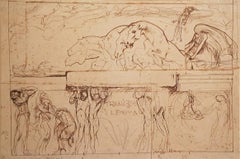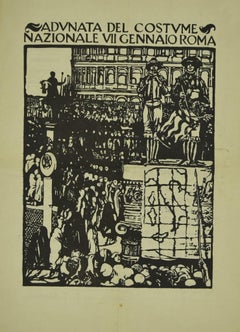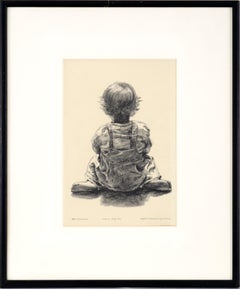Giulio Aristide Sartorio Figurative Prints
Italian, 1860-1932
Giulio Aristide Sartorio was an Italian painter and film director from Rome. Alongside the activity of landscape artists who saw him, in 1904, he was also among the promoters of the XXV group of the Roman Campagna. He also had numerous public commissions like the famous decorative frieze for the new parliament hall (1908–12), which merges literary inspiration with refined design elegance.
to
1
1
Overall Width
to
Overall Height
to
2
4
851
382
379
308
2
1
1
2
2
1
1
1
1
1
1
1
1
2
Artist: Giulio Aristide Sartorio
Sketch for the Parliament Hall “Thanatos and the Enigma” - 1900s - Drawing
By Giulio Aristide Sartorio
Located in Roma, IT
Original drawing, pencil on paper. A wonderful sketch for the frieze for Parliament Hall in Montecitorio Palace, in Rome.
Good conditions except for a diffused foxing, including a w...
Category
Early 1900s Modern Giulio Aristide Sartorio Figurative Prints
Materials
Ink
Gathering of the Costume - Woodcut by G.A. Sartorio -1938
By Giulio Aristide Sartorio
Located in Roma, IT
Gathering of the Costume is a woodcut print realized by Giulio Aristide Sartorio in 1938.
The album composed of 10 pages, was realized for the Royal wedding of King Umberto of Savoy...
Category
1930s Modern Giulio Aristide Sartorio Figurative Prints
Materials
Woodcut
Related Items
"The Little One" - Rare Signed Figurative Lithograph in Ink on Paper
Located in Soquel, CA
"The Little One" - Figurative Lithograph in Ink on Paper
Bold lithograph by Eugene Hawkins (American, b. 1933). A young child is kneeling, facing away ...
Category
1960s American Modern Giulio Aristide Sartorio Figurative Prints
Materials
Paper, Ink, Lithograph
$540 Sale Price
20% Off
H 20.75 in W 16.75 in D 0.5 in
Wedding Party
Located in Buffalo, NY
An original mid century modern woodblock print.
This work is hand signed illegibly and titled "Wedding Party".
Category
1960s Modern Giulio Aristide Sartorio Figurative Prints
Materials
Paper, Woodcut
Painting and etching 70x50 cm, Chahab, 2N Gallery New York
Located in Riga, LV
Painting and etching
70x50 cm, Chahab, 2N Gallery New York
Category
21st Century and Contemporary Modern Giulio Aristide Sartorio Figurative Prints
Materials
Paper, Printer's Ink
$169 Sale Price
20% Off
H 27.56 in W 19.69 in D 0.04 in
Peace
By Anton Refregier
Located in Fairlawn, OH
Peace
Woodcut printed in orange red ink on japanese paper
Signed and titled in pencil lower right (see photo)
Titled lower left (see photo)
Created along with an illustrated book project Song of Peace, 1950-1959.
Condition: Excellent
Image: 10 1/2 x 4 7/8"
Sheet: 16 1/8 x 7";
Anton Refregier (March 20, 1905 – October 10, 1979) was a painter and muralist active in Works Progress Administration Federal Art Project commissions, and in teaching art. He was a Russian immigrant to the United States.
Among his best-known works is his mural series The History of San Francisco, located in the Rincon Center in downtown San Francisco, California. It depicts the city's history across twenty seven panels that he painted from 1940 to 1948.
Life and early career
Refregier was born in Moscow and emigrated to the United States in 1920. After working various odd jobs in New York City, he earned a scholarship to the Rhode Island School of Design in 1921. After finishing school, Refregier moved back to New York in 1925. To earn a living, Refregier worked for interior decorators, creating replicas of François Boucher and Jean-Honoré Fragonard paintings...
Category
1950s American Modern Giulio Aristide Sartorio Figurative Prints
Materials
Woodcut
No Footprints Show, Where the Flowers Grow Deep
By Shiko Munakata
Located in Fairlawn, OH
No Footprints Show, Where the Flowers Grow Deep
Woodcut, 1961
Unsigned (as isssued)
From: The "Way" of the Woodcut, three woodcuts, 1961
Publisher: Pratt Adlib Press, Brooklyn, New Y...
Category
1960s Modern Giulio Aristide Sartorio Figurative Prints
Materials
Woodcut
"Leonard Bernstein" - Rare Signed Figurative Lithograph in Ink on Paper
Located in Soquel, CA
"Leonard Bernstein" - Figurative Lithograph in Ink on Paper
Bold lithograph by Eugene Hawkins (American, b. 1933). Leonard Bernstein is raising both ha...
Category
1960s American Modern Giulio Aristide Sartorio Figurative Prints
Materials
Paper, Ink, Lithograph
$540 Sale Price
20% Off
H 20.75 in W 16.75 in D 0.5 in
Gerry Mulligan, Baritone Sax - Rare Signed Figurative Lithograph in Ink on Paper
Located in Soquel, CA
Gerry Mulligan, Baritone Sax - Rare Signed Figurative Lithograph in Ink on Paper
Bold lithograph by Eugene Hawkins (American, b. 1933). Gerry Mulligan sits on a stool holding his ba...
Category
1960s American Modern Giulio Aristide Sartorio Figurative Prints
Materials
Paper, Ink, Lithograph
Eugene HawkinsGerry Mulligan, Baritone Sax - Rare Signed Figurative Lithograph in Ink on Paper, 1963
$1,100
H 20 in W 16 in D 0.25 in
Stevan Dohanos, Backyard
By Stevan Dohanos
Located in New York, NY
Stevan Dohanos was an accomplished draftsman who work was widely known through the Saturday Evening Post. This print 'Backyard,' however, leaves aside the illustrative magazine work ...
Category
1930s American Modern Giulio Aristide Sartorio Figurative Prints
Materials
Woodcut
Winter on Cruise
By Jim Dine
Located in New York, NY
A very good impression of this color woodcut and lithograph diptych. Signed and dated in pencil by Dine. From a limited edition of 12.
Category
Early 2000s Modern Giulio Aristide Sartorio Figurative Prints
Materials
Color, Lithograph, Woodcut
By Night On My Bed
Located in New York, NY
Woodcut. Signed by the artist and dated in pencil, lower right. Titled in pencil, lower left, and numbered "28" in pencil, lower center.
This woodcut was made by Esherick to ill...
Category
1920s American Modern Giulio Aristide Sartorio Figurative Prints
Materials
Woodcut
Alexander Calder Mid Century Derrière le Miroir Lithograph
By Alexander Calder
Located in Soquel, CA
Vintage 1960s Alexander Calder Lithograph double page part of portfolio "Derriere le Miroir". Published by: Galerie Maeght, Paris, 1966. No. 156. Text on verso. Unsigned, from an unknown edition. Presented in black mat with red core. Mat size: 20"H x 24"W. Image size: 15"H x 22"W.
American artist Alexander Calder changed the course of modern art by developing an innovative method of sculpting, bending, and twisting wire to create three-dimensional “drawings in space.” Resonating with the Futurists and Constructivists, as well as the language of early nonobjective painting, Calder’s mobiles (a term coined by Marcel Duchamp in 1931 to describe his work) consist of abstract shapes made of industrial materials––often poetic and gracefully formed and at times boldly colored––that hang in an uncanny, perfect balance. His complex assemblage Cirque Calder (1926–31), which allowed for the artist’s manipulation of its various characters presented before an audience, predated Performance Art by some 40 years. Later in his career, Calder devoted himself to making outdoor monumental sculptures...
Category
1960s Modern Giulio Aristide Sartorio Figurative Prints
Materials
Paper, Ink
$1,100 Sale Price
20% Off
H 20 in W 24 in D 0.33 in
Mid-Century Derrière le Miroir Lithograph by Alexander Calder
By Alexander Calder
Located in Soquel, CA
Mid-Century Derrière le Miroir Lithograph by Alexander Calder
Vintage 1960's Alexander Calder double-page Lithograph, unsigned, part of portfolio "Derriere le Miroir". Published by:...
Category
1960s Modern Giulio Aristide Sartorio Figurative Prints
Materials
Paper, Ink
$1,050
H 24 in W 30 in D 0.33 in
Giulio Aristide Sartorio figurative prints for sale on 1stDibs.
Find a wide variety of authentic Giulio Aristide Sartorio figurative prints available for sale on 1stDibs. You can also browse by medium to find art by Giulio Aristide Sartorio in ink, woodcut print and more. Much of the original work by this artist or collective was created during the 20th century and is mostly associated with the modern style. Not every interior allows for large Giulio Aristide Sartorio figurative prints, so small editions measuring 13 inches across are available. Customers who are interested in this artist might also find the work of Giorgio De Chirico, Giorgio Morandi, and Massimo Campigli. Giulio Aristide Sartorio figurative prints prices can differ depending upon medium, time period and other attributes. On 1stDibs, the price for these items starts at $1,393 and tops out at $8,355, while the average work can sell for $4,874.


